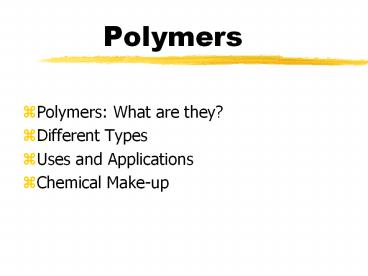Polymers - PowerPoint PPT Presentation
Title:
Polymers
Description:
Chemical Make-up. Polymers - What are they? Polymers are a special kind of macromolecule ... There are two basic types of synthetic polymers. Thermoplastics ... – PowerPoint PPT presentation
Number of Views:73
Avg rating:3.0/5.0
Title: Polymers
1
Polymers
- Polymers What are they?
- Different Types
- Uses and Applications
- Chemical Make-up
2
Polymers - What are they?
- Polymers are a special kind of macromolecule
- The word polymer comes from the Greek words
poly, meaning many, and meres, meaning
parts or repeating units - A Polymer consists of a large chain of repeating
molecules (monomers) that are attached in an end
to end fashion
3
Description of Polymers
- Imagine a string of beads
- Each bead is identical (for example, red sphere)
- Represents the mer
- The string can contain 100s of beads
- Represents the poly characteristic
- The string in between the beads represents the
chemical bond between monomers
4
Length of Polymers
- Polymer chains are HUGE!
- Polymers typically consist of between 20,000 and
40,000 individual monomers - If each bead on the string of beads were one inch
apart, one polymer molecule could be as long as
10 football fields!!! - This chain length is what gives the polymer most
of its desirable characteristics
5
Description of Polymers
- Polymer chains are flexible, and usually clump
together into a smaller shape - This enables the individual chains to interact
and become entangled - This helps to give a polymer its strength and
flexibility
6
Types of Polymers
- There are two main types of polymers
- Natural
- (cotton, silk, wood, leather)
- Synthetic
- (plastics, nylon, latex)
7
Synthetic Polymers
- There are two basic types of synthetic polymers
- Thermoplastics (plastics, Styrofoam)
- These can be softened by heating and hardened by
cooling - easily recycled - Can easily be cast into various shapes
- Thermosets (epoxys, adhesives)
- These harden after being heated
- Can easily be cast into different shapes
- Cannot be reformed
8
Types of Polymers - Copolymers
- Most polymer chains are made up of one type of
monomer (for example, red beads) - However, some polymers are made up of different
types of monomers (for example, blue and red
beads) - these are called copolymers
9
Copolymers
- There are four main types of copolymers
- The different monomers can be arranged either in
an alternating or random fashion - Alternating
- ...-red-blue-red-blue-red-blue-red-blue-red-
- Random
- -blue-red-red-blue-red-blue-blue-red-blue-
10
Copolymers
- There are also block copolymers and graft
co-polymers - Block
- -R-R-R-R-R-R-B-B-B-B-B-B-R-R-R-R-R-R-
- Graft
- -R-R-R-R-R-R-R-R-R-R-R-R-R-R-R-R-R-
- B-B-B-B-B-B-B-B-B-
11
Polymers - Pros and Cons
- A polymer has many very advantageous properties.
Polymers are - Lightweight
- Strong and durable
- Cheap
- Easy to manufacture
- Unfortunately, polymers do not easily biodegrade
and end up producing large amounts of waste
12
Uses of Polymers
- Polymers are incorporated into nearly every
aspect of daily life - Entertainment
- Sports
- Clothes
- Hobbies/Toys
- Household products
- Automotive
13
Polymer Chemistry
- A polymer chain is built on a Carbon backbone
- A monomer unit consists of a small carbon chain
attached to a specific type of functional group - The functional group is what gives each polymer
chain its individual characteristics
14
Polymer Chemistry
- As previously stated, polymer chains interact
with one another, becoming entangled - Polymer chains also form cross-links with
adjacent chains, which allows the polymer to hold
its shape and gives added strength
15
Summary
- Polymers are made up of large chains of repeating
units, called monomers - Individual chains interact to form a stronger
overall substance through entanglements and
cross-links - Polymers are incorporated into almost every
aspect of daily life - Polymers are lightweight, strong, and inexpensive































